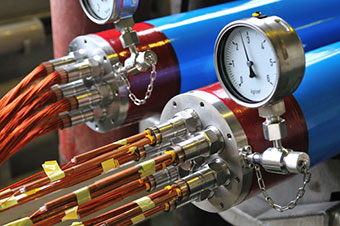
Pressure
Pressure is a quantity derived from the unit of force. Absolute, atmospheric, and gauge pressure are used to express the magnitude of a measured pressure. The unit selected depends on the reference to which the pressure is compared and in some instances, the magnitude of the pressure. The relationship of absolute, atmospheric, and gauge pressure is:

Absolute Pressure – Absolute pressure is defined as “the actual pressure measured at a point using absolutely no pressure as a reference point.” The unit of absolute pressure is pounds per square inch absolute, or psia.
Gauge Pressure – Gauge pressure is defined as the “relative reading of pressure inside a container compared to the atmospheric pressure outside the container when the internal pressure is greater than atmospheric.” The term “gauge” refers to the act of measuring, or gauging, the relative pressure above atmospheric. The unit of gauge pressure is pounds per square inch gauge, or psig.
Pressure Measurement
Pressure is a straightforward parameter to measure. The two basic means of measuring pressure are hydrostatic force and mechanical motion.

Hydrostatic Force
Hydrostatic gauges compare pressure to the hydrostatic force per unit area at the base of a column of fluid. The two main types are piston and liquid column.
Piston-Type Gauges – Piston-type gauges counterbalance the pressure of a fluid with a spring such as a tire gauge or a solid weight, known as a deadweight tester. The deadweight tester is an accurate device for measuring pressure and relies on Pascal’s Law: “Pressure in a liquid-filled container is felt equally throughout the container.” These types of gauges are impractical for pressure measurement in the field and are used almost exclusively to calibrate other pressure gauges.
Liquid Column – Liquid column gauges, known as manometers, are one of the oldest, simplest, most direct, and accurate devices used for measuring pressure. This device is a U-shaped glass or plastic tube. It is open at both ends and contains a liquid such as water, mercury, alcohol, or oil.
Mechanical Motion
The three main types of mechanical force devices used in industry are diaphragms, bellows, and bourdon tubes.

Diaphragm – The diaphragm is a flexible membrane that deflects and separates two areas of different pressure. The amount of deflection is repeatable for specific pressures so the pressure can be determined using calibration. The reference side can be open to atmosphere to measure gauge pressure, open to a second port to measure differential pressure, or sealed against a vacuum or other fixed reference pressure to measure absolute pressure.

Bellows – The need for a pressure sensing element that was extremely sensitive to low pressures and provided power to activate, record, and indicate mechanisms resulted in the development of the metallic bellows’ pressure sensing element. The metallic bellows is most accurate at pressures from 0.5 to 75 psig. However, when used in conjunction with a heavy range spring, some bellows can be used to measure pressures of over 1,000 psig.

Bourdon Tube – The Bourdon Tube uses displacement distance to measure pressure. Bourdon tubes come in three basic types: C-type, spiral-type, and helical-type.

C-Type Bourdon Tube – A C-type bourdon tube is fabricated by flattening the side of a hollow tube, then bending the tube into the shape of a “C.” One end of the tube is sealed and the other end is fixed to a support base. The material of the tube is selected for its elastic properties because it can deform under pressure then return to its original shape when pressure is removed. The actual amount of tip displacement is relatively small, about 1/4 inch. The small and nonlinear tip-motion characteristics are compensated for mechanically.

Spiral-Type Bourdon Tube – One limitation of the C-type bourdon tube is the relatively small amount of tip movement. A spiral-type bourdon tube provides more tip movement.
The spiral-type tube works under the same observed principles as the C-type, but as the applied pressure increases, the spiral uncoils. Because of the increased tip movement, mechanical amplification is not normally needed. This results in an increase in sensitivity and accuracy because there is no lost motion from loose or sticking links, levers, or gears.

Helical-Type Bourdon Tube – A helical-type bourdon tube provides even greater tip movement than the spiral-type. High-pressure helical-types might have as many as twenty coils, while low-pressure helical-types might have two or three coils. Since the change in tip motion decreases as the applied pressure becomes larger, adding more coils compensates for this motion decrease.
The expert consultants at Technology Transfer Services are available to assist you with anything industrial related, including Process Measurement. Give us a call today at (813) 908-1100 to see what TTS can do for you!

